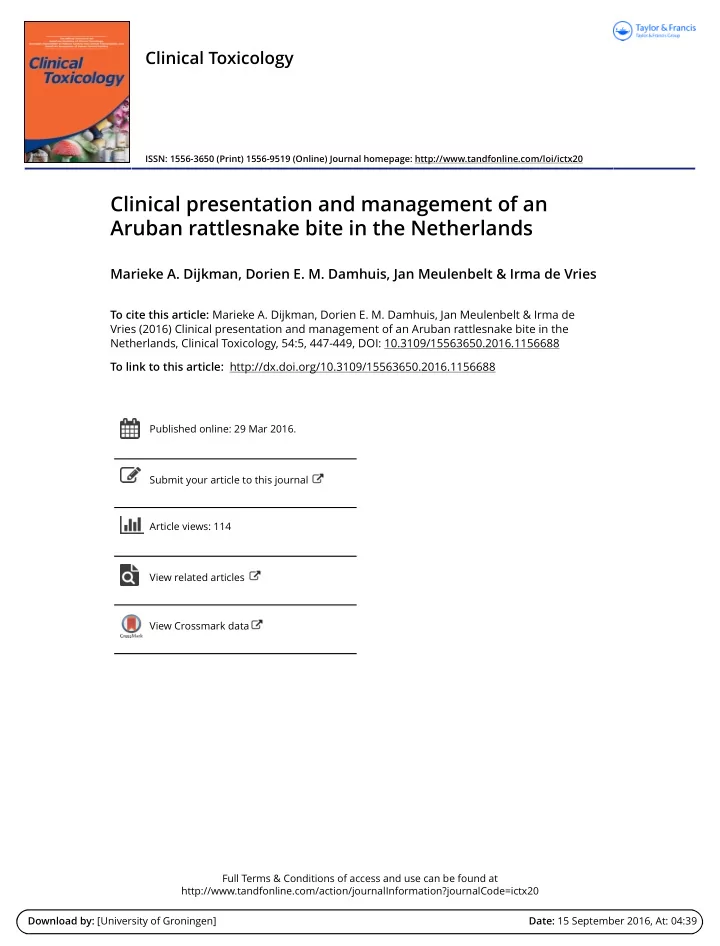

Clinical Toxicology ISSN: 1556-3650 (Print) 1556-9519 (Online) Journal homepage: http://www.tandfonline.com/loi/ictx20 Clinical presentation and management of an Aruban rattlesnake bite in the Netherlands Marieke A. Dijkman, Dorien E. M. Damhuis, Jan Meulenbelt & Irma de Vries To cite this article: Marieke A. Dijkman, Dorien E. M. Damhuis, Jan Meulenbelt & Irma de Vries (2016) Clinical presentation and management of an Aruban rattlesnake bite in the Netherlands, Clinical Toxicology, 54:5, 447-449, DOI: 10.3109/15563650.2016.1156688 To link to this article: http://dx.doi.org/10.3109/15563650.2016.1156688 Published online: 29 Mar 2016. Submit your article to this journal Article views: 114 View related articles View Crossmark data Full Terms & Conditions of access and use can be found at http://www.tandfonline.com/action/journalInformation?journalCode=ictx20 Download by: [University of Groningen] Date: 15 September 2016, At: 04:39
CLINICAL TOXICOLOGY, 2016 VOL. 54, NO. 5, 447–449 http://dx.doi.org/10.3109/15563650.2016.1156688 SHORT COMMUNICATION Clinical presentation and management of an Aruban rattlesnake bite in the Netherlands Marieke A. Dijkman a , Dorien E. M. Damhuis b , Jan Meulenbelt a,c,d and Irma de Vries a a Dutch Poisons Information Center, University Medical Center Utrecht, Utrecht, Netherlands; b Emergency Department, Ziekenhuisgroep Twente (ZGT), Almelo, Netherlands; c Department of Intensive Care Medicine, University Medical Center Utrecht, Utrecht, Netherlands; d Institute for Risk Assessment Sciences, Utrecht University, Utrecht, Netherlands ABSTRACT ARTICLE HISTORY Bites by Aruban Rattlesnake ( Crotalus durissus unicolor ) are rare and not known to induce severe enve- Received 1 December 2015 Revised 21 January 2016 nomations. Here, we present a case of a 57 year-old man bitten by his pet Aruban Rattlesnake ( Crotalus Accepted 16 February 2016 durissus unicolor ). He was admitted to hospital within 15 min. Three and a half hours later his fibrinogen Published online 24 March concentration decreased to 0.6 g/L (normal: 2.0–4.0). Nine hours post-bite, he was treated with polyva- 2016 lent snake antivenom covering Crotalus durissus . Three hours later his fibrinogen became undetectable while at that time clotting times were prolonged (PT 38.7 s (normal: 12.5–14.5) and aPTT 40 s (normal: KEYWORDS 25–35)). His platelet count remained within normal limits. Creatine kinase (CK) concentrations reached a Antivenom; haematotoxicity; maximum of 1868 U/L (normal: < 200) 16 h post-bite. After a second antivenom dose, 10.5 h after the national serum depot; first antivenom administration, clotting times returned to normal. Fibrinogen was restored to normal venomous exotic snakebite within three days. He was discharged from hospital on day five. In conclusion, administration of polyva- lent snake antivenom covering Crotalus durissus snakebites shows cross-neutralization and is effective in the treatment of patients bitten by Crotalus durissus unicolor . Introduction polyvalent antivenom containing equine derived lyophilized antibody fragments (Fab2) against Crotalus durissus venom. Admission of an exotic venomous snakebite victim at an Meanwhile, the patient was transferred to the intensive care Emergency Department (ED) is a rare event. In the Netherlands, unit (ICU) for observation. Three and a half hours post-bite it is allowed to keep venomous animals, provided they are kept 14.1 � 10 9 /L his leukocyte count was (normal: 4.0–10.0), in a non-dangerous manner. However, accidental bites, mostly thrombocyte count 288 � 10 9 /L (normal: 150–400), fibrinogen involving the owners of these animals, do occur. Each year, the 0.6 g/L (normal: 2.0–4.0), prothrombin time (PT) 10.8 s (normal: Dutch Poisons Information Center (DPIC) is consulted about 4–6 12.5–14.5), and activated partial thromboplastin time (aPTT) venomous exotic snakebites.[1] The DPIC offers information on 28 s (normal: 25–35). He still experienced nausea and local the clinical presentation of envenomations and treatment, pain; the swelling had progressed to his entire hand. Twelve including the choice of and criteria for antivenom treatment. vials Antivipmyn TRI were diluted and administered intraven- The DPIC assists in ordering the antivenom from the Dutch ously 9h post-bite. Three hours later, fibrinogen was undetect- National Serum Depot, part of the National Institute for Public able ( < 0.6 g/L), PT 38.7 s, aPTT 40 s (Table 1). Additional Health and the Environment.[1] Here, we present a case of an antivenom was ordered. Meanwhile, 4 h later, his creatine kin- amateur herpetologist bitten by an Aruban rattlesnake. ase (CK) reached a maximum of 1,868 U/L. Edema had pro- gressed to the underarm, but the overall condition of the Case report patient did not deteriorate any further. Another six vials of antivenom were administered 10.5 h after the first antivenom A 57-year-old man was bitten in his right index finger while dose. Thereafter, clotting times recovered completely. feeding his 1.5-year old Aruban rattlesnake. Paramedics Fibrinogen was within normal limits three days post-bite. He reported that he fainted a few times during transport to the was discharged five days post-bite with some remaining par- hospital. However, upon arrival at the ED 15 min post-bite, his esthesia and hyperesthesia at the bite site. Soon after dis- blood pressure was 151/84 mmHg, pulse 95/min, respiration charge, he developed a local infection at the bite site which 23 breaths/min, with a saturation of 99% on room air. He was treated with antibiotics (type unknown). Six months later, complained about nausea and pain in his finger. Physical local hyperesthesia at the bite site still persisted. examination revealed two bite marks, and mild swelling and erythema of the proximal phalanx. The DPIC was consulted to Discussion discuss this envenomation, as well as criteria for antivenom treatment.[2] The DPIC advised and assisted in ordering anti- Following the bite of an Aruban Rattlesnake, this patient venom (Antivipmyn TRI, Institute Bioclon, Mexico), a developed snake venom induced coagulopathy consisting of CONTACT Marieke A Dijkman M.Dijkman-2@umcutrecht.nl Dutch Poisons Information Center, University Medical Center Utrecht, P.O. Box 85500, 3508 GA Utrecht, the Netherlands � 2016 Informa UK Limited, trading as Taylor & Francis Group
Recommend
More recommend